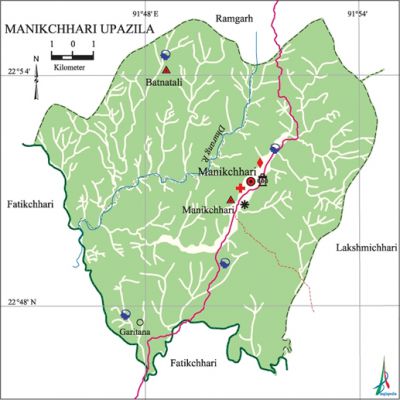Manikchhari Upazila
Manikchhari Upazila (khagrachhari district) area 168.34 sq km, located in between 22°41' and 22°55' north latitudes and in between 89°35' and 89°52' east longitudes. It is bounded by ramgarh upazila on the north, fatikchhari upazila on the south, lakshmichhari upazila on the east, Fatikchhari upazila on the west.
Population Total 61589; male 30939, female 30650; Muslim 40536, Hindu 6277, Buddhist 14308, Christian 432 and others 36.
Water bodies Main river: Dhurang.
Administration Manikchhari Thana was formed on 10 December 1980 and it was turned into an upazila 1985.
| Upazila | ||||||||
| Municipality | Union | Mouza | Village | Population | Density (per sq km) | Literacy rate (%) | ||
| Urban | Rural | Urban | Rural | |||||
| - | 4 | 12 | 160 | 34776 | 26813 | 366 | 44.9 | 35.2 |
| Upazila Town | ||||||||
|
Area (sq km) |
Mouza |
Population |
Density (per sq km) |
Literacy rate (%) | ||||
| 75.11 | 2 | 34776 | 463 | 44.9 | ||||
| Union | ||||
| Name of union and GO code | Area (acre) | Population | Literacy rate (%) | |
| Male | Female | |||
| Batnatali 19 | 16000 | 6323 | 6358 | 37.1 |
| Manikchhari 63 | 25600 | 11021 | 10577 | 48.7 |
| Juggachhala 42 | - | 5701 | 5655 | 37.4 |
| Tintahari 87 | - | 7894 | 8060 | 35.1 |
Source Bangladesh Population Census 2011, Bangladesh Bureau of Statistics.

Archaeological heritage and relics Mung Rajbari, Sindukchhari Pond, Sundar Shah Tomb.
War of Liberation Freedom fighters of the upazila formed a resistance at Joggochala Bazar to prevent Pakistani soldiers from entering the area. Freedom fighters had an encounter with the Pak army at Nonabil of Joggochala.
For details: see মানিকছড়ি উপজেলা, বাংলাদেশ মুক্তিযুদ্ধ জ্ঞানকোষ (Encyclopedia of Bangladesh War of Liberation), বাংলাদেশ এশিয়াটিক সোসাইটি, ঢাকা ২০২০, খণ্ড ৮।
Literacy rate and educational institutions Average literacy 40.7%; male 44.1%, female 37.3%. Educational institutions: college 1, secondary school 2, primary school 50. Noted educational institutions: Rani Nihar Devi Government High School (1976).
Newspapers and periodicals Weekly: Chabuk.
Cultural organisations Library 1, cinema hall 1.
Main sources of income Agriculture 67.32%, non-agricultural labourer 6.68%, industry 0.27%, commerce 10.9%, transport and communication 0.8%, service 5.69%, construction 0.46%, religious service 0.32%, rent and remittance 0.37% and others 7.19%.
Ownership of agricultural land Landowner 50.01%, landless 49.99%; agricultural landowner: urban 52.07% and rural 47.36%.'
Main crops Paddy, corn, mustard, potato, ginger, turmeric, vegetables.'
Main fruits Banana, jackfruit, lemon, pineapple.
Fisheries, dairies and poultries Poultry 10.
Communication facilities Pucca road 40 km, semi-pucca road 155 km, mud road 300 km.
Extinct or nearly extinct traditional transport Bullock cart.
Noted manufactories Rice mill, flour mill, saw mill.
Cottage industries Weaving, potteries, embroidery, wood work, bamboo work, cane work.
Hats, bazars and fairs Hats and bazars are 7, fairs 2, most noted of which are Manikchhari Bazar, Mahamuni Bazar, Gachhabil Bazar, Tintahri Bazar, Chaitra Sankranti Mela adjacent to Mahamuni Temple.
Main exports Banana, jackfruit, ginger, turmeric, vegetables, bamboo, cane, wood.
Access to electricity All the unions of the upazila are under rural electrification net-work. However 24.5% of the dwelling households have access to electricity.
Natural resources Natural gas (Juiggachhara Chimuthang Gas Field).
Sources of drinking water Tube-well 67.3%, tap 0.4% and others 32.3%.
Sanitation 39.3% of dwelling households of the upazila use sanitary latrines and 45.4% of dwelling households use non-sanitary latrines; 15.3% of households do not have latrine facilities.
Health centres Upazila health complex 1, family planning clinic 1, diagnostic centre 4. [Atikur Rahman]
References Bangladesh Population Census 2001 and 2011, Bangladesh Bureau of Statistics; Cultural survey report of Manikchhari Upazila 2007.
